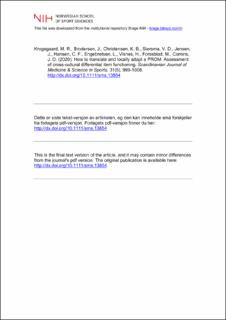| dc.contributor.author | Krogsgaard, Michael R. | |
| dc.contributor.author | Brodersen, John | |
| dc.contributor.author | Christensen, Karl B | |
| dc.contributor.author | Siersma, Volkert Dirk | |
| dc.contributor.author | Jensen, Jonas | |
| dc.contributor.author | Hansen, Christian Fugl | |
| dc.contributor.author | Engebretsen, Lars | |
| dc.contributor.author | Visnes, Håvard | |
| dc.contributor.author | Forssblad, Magnus | |
| dc.contributor.author | Comins, Jonathan D. | |
| dc.date.accessioned | 2021-10-20T10:51:34Z | |
| dc.date.available | 2021-10-20T10:51:34Z | |
| dc.date.created | 2020-12-04T11:11:40Z | |
| dc.date.issued | 2020 | |
| dc.identifier.citation | Scandinavian Journal of Medicine & Science in Sports. 2020, 31(5), 999-1008 | en_US |
| dc.identifier.issn | 0905-7188 | |
| dc.identifier.uri | https://hdl.handle.net/11250/2824090 | |
| dc.description | Dette er siste tekst-versjon av artikkelen, og den kan inneholde små forskjeller fra forlagets pdf-versjon. Forlagets pdf-versjon finner du her: http://dx.doi.org/10.1111/sms.13854 / This is the final text version of the article, and it may contain minor differences from the journal's pdf version. The original publication is available here: http://dx.doi.org/10.1111/sms.13854 | en_US |
| dc.description.abstract | Translating patient‐reported outcome measures (PROMs) can alter the meaning of items and undermine the PROM's psychometric properties (quantified as cross‐cultural differential item functioning [DIF]). The aim of this paper was to present the theoretical background for PROM translation, adaptation, and cross‐cultural validation, and assess how PROMs used in sports medicine research have been translated and adapted. We also assessed DIF for the Knee Injury and Osteoarthritis Outcome Score (KOOS) across Danish, Norwegian, and Swedish versions. We conducted a search in PubMed and Scopus to identify the method of translation, adaptation, and validation of PROMs relevant to musculoskeletal research. Additionally, 150 preoperative KOOS questionnaires were obtained from the Scandinavian knee ligament reconstruction registries, and cross‐cultural DIF was evaluated using confirmatory factor analysis and Rasch analysis. There were 392 studies identified, describing the translation of 61 PROMs. Ninety‐four percent were performed with forward‐backward technique. Forty‐nine percent used cognitive interviews to ensure appropriate wording, understandability, and adaptation to the target culture. Only two percent were validated according to modern test theory. No study assessed cross‐cultural DIF. One KOOS subscale showed no cross‐cultural DIF, two had DIF with respect to some (but not all) items, and thus conversion tables could be constructed, and two KOOS subscales could not be pooled. Most PROM translations are of undocumented quality, despite the common conclusion that they are valid and reliable. Scores from three of five KOOS subscales can be pooled across the Danish, Norwegian, and Swedish versions, but two of these must be adjusted for DIF. | en_US |
| dc.language.iso | eng | en_US |
| dc.subject | cognitive interview | en_US |
| dc.subject | construct validity | en_US |
| dc.subject | cultural adaption | en_US |
| dc.subject | data pooling | en_US |
| dc.subject | differential item functioning | en_US |
| dc.subject | knee ligament reconstruction registry | en_US |
| dc.subject | PROMs | en_US |
| dc.subject | translation | en_US |
| dc.title | How to translate and locally adapt a PROM: Assessment of cross‐cultural differential item functioning | en_US |
| dc.type | Peer reviewed | en_US |
| dc.type | Journal article | en_US |
| dc.description.version | acceptedVersion | en_US |
| dc.source.pagenumber | 10 | en_US |
| dc.source.journal | Scandinavian Journal of Medicine & Science in Sports | en_US |
| dc.identifier.doi | 10.1111/sms.13854 | |
| dc.identifier.cristin | 1856168 | |
| dc.description.localcode | Institutt for idrettsmedisinske fag / Department of Sports Medicine | en_US |
| cristin.ispublished | true | |
| cristin.fulltext | postprint | |
| cristin.qualitycode | 2 | |
